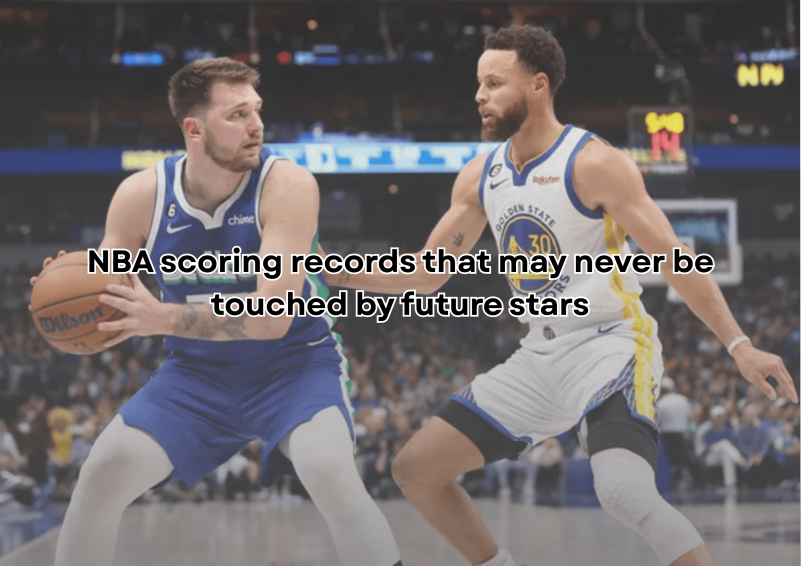
When you watch NBA games today you see players pop off for 50-point nights, even streaks of three or four in a row. But the list you’re about to read dives into scoring feats that feel locked in history, performances so extreme, so anchored in their era, they stand as giant monuments to what was once possible. We’ll look at ten records in scoring that combine sheer volume, longevity, context and legacy and ask: could any of these ever be matched again?
Context
Scoring records in the NBA do more than splash highlights. They mark shifts in pace, rule changes, athlete conditioning, strategy and culture. A record from the 1960s often reflects far different game tempo, defending style, roster construction than today. So when one stands strong across decades it tells you about a threshold that has become nearly unreachable.
Also, stats collectors, media and fans treat such records as milestones for conversations, who’s the best ever, could anyone break this, so the gravity of a record matters beyond the numbers.
Methodology: Data drawn from official NBA leaderboards and trusted aggregators. Ranking criteria: performance, longevity, impact. Era adjustments noted by context but not formally quantified. Ties or near ties are ranked on additional context such as number of games and era.
The Records That Should Stay Untouched
1. 100-point game
On March 2, 1962, Wilt Chamberlain scored 100 points for the Philadelphia Warriors in a 169 to 147 win over the New York Knicks. The game took place in Hershey, Pennsylvania, with just over 4,000 fans present.
This is a milestone. No other player has reached 100 in a league game. The next highest single game mark is 81 points by Kobe Bryant.
The crowd that night, and anyone who was there still talks about the humidity and the intensity, went absolutely silent once the 90 point mark passed. Teammates cleared out so Wilt could shoot more.
Legacy: It stands as a freak of nature gaming environment, pace, defense, maybe even team strategy that helped it happen. The thought of doing it in an era of zone defense, load management and analytics makes it feel nearly untouchable.
2. 50.4 points per game in a season
In the 1961 to 62 season Chamberlain averaged 50.4 points per game across 80 games.
To put that in modern context, few players today even average 30 ppg, let alone pass 40.
Behind the scenes: he played nearly 48.5 minutes per game that season, often logging the entire game.
Emotionally, for fans of that era it felt like you were watching someone doing things in a blur, margins erased. That kind of dominance changes how defenders guard you, how teammates adjust.
Ripple effect: It shifted how the NBA thought about scoring capacity and superstar load. But in today’s spacing, sharing and pace environment, it’s very hard to imagine someone averaging 50 again.
3. 4,029 points in one season
Chamberlain also holds the record for most total points scored in a regular season, 4,029 in 1961 to 62.
Why it matters: It’s a volume record. You have to stay healthy, maintain extremely high scoring output and play enough minutes to accumulate that many.
Comparison: In recent decades even stars who average high volumes rarely reach 3,000 points, let alone 4,000.
Behind the scenes: He had few off nights, teammates were conditioned to feed him the ball.
Impact: It anchors his season as maybe the greatest scoring season the league has seen.
4. 45 fifty-point games in one season
Chamberlain had 45 games with 50 or more points in that 1961 to 62 season.
Modern context: Most recent high scoring season players might have 10 such games, maybe 12 in a hot stretch. But 45 is four times as many.
Behind the scenes: More than half the games he played he scored 50 or more.
Fan memory: People still talk about that season, you’d expect 50 point nights were just normal for Wilt.
Legacy: It’s a benchmark for what a scoring machine can do for a season.
5. 63 forty-point games in one season
Again in 1961 to 62, Chamberlain had 63 games with 40 or more points.
To compare: A star today hitting 40 or more maybe 30 times in a season would be remarkable.
Personal note: I’ve watched replay after replay of 60 point plus games, and you still sense how often he scored 40 or more.
Cultural impact: For fans of scoring, it establishes that season as a scoring clinic.
Effect now: With load management, fewer minutes and more parity, reaching 63 forty point nights feels unthinkable.
6. 118 career fifty-point games
Over his career, Chamberlain posted 118 games scoring 50 or more points.
Why it matters: It’s sustained dominance.
Modern context: The second most is Michael Jordan with 31. So Chamberlain has nearly four times as many.
Behind the scenes: He had to stay healthy, maintain a role as primary scorer for years and fight through heavy defensive attention.
Emotional layer: Each time a player hits 50 today the crowd reacts like it’s rare. Back then for Wilt those nights were semi routine.
Legacy: It becomes a bar no modern player is close to touching.
7. Most career points
LeBron James currently leads the NBA all time regular season points list with more than 42,000 points.
Why this one is special: On one hand it’s reachable in theory. But you need elite level scoring for 20 or more seasons.
Comparison: Many greats retire far below that number.
Behind the scenes: He adapted his game, stayed durable, changed teams, changed roles and kept collecting points.
Impact: It’s the standard for longevity combined with scoring.
8. Highest career scoring average
The highest career points per game average in NBA regular season belongs to Michael Jordan at just over 30 ppg.
Why it’s a pure metric: It normalizes for longevity by judging every game.
Modern context: Few stars now approach 30 ppg over a career because of role sharing and fewer minutes.
Behind the scenes: Jordan carried a heavy scoring load each season he played.
Cultural layer: Fans remember how Jordan made scoring look effortless, and this number shapes that memory.
9. Most consecutive games with 30 or more points
Chamberlain started the 1961 to 62 season with 65 consecutive games scoring 30 or more points.
Why it matters: It’s consistency each night across months.
Modern context: A 10 game streak today makes headlines. 65 stretches across nearly half the season.
Personal observation: When modern stars hit 15 to 20 points and it’s called a quiet night, this streak feels like another world.
Emotional: For opponents, to face someone who scores 30 or more nightly means preparing differently every week.
10. Most seasons leading the league in scoring
Chamberlain and Jordan each led the NBA in points per game for 7 seasons.
Why this matters: Leading the league defines you as the top scorer among peers. Doing it 7 times means sustained supremacy.
Modern context: With roster changes and star clusters, leading the league even 2 or 3 times is hard.
Behind the scenes: Coaches trusted them, they rarely missed games and they kept scoring enough to stay at the top.
Cultural layer: It shaped how both players were defined. The scorer of the era.
What Comes Next
So where does that leave us? We still see superstars scoring at high rates, hitting milestones, but the NBA today makes it hard for one player to control scoring across a whole season the way legends once did. Pace is higher, but so is sharing. Defenses adapt faster. Bench units play larger roles.
A younger fan might ask if someone could break one of these. Maybe. But taking a good hard look, I don’t think one will.
And if I’m honest, some records should stay untouchable. They separate the eras.
Also Read: https://info-vista.com/nba-role-players-cult-favorites/



